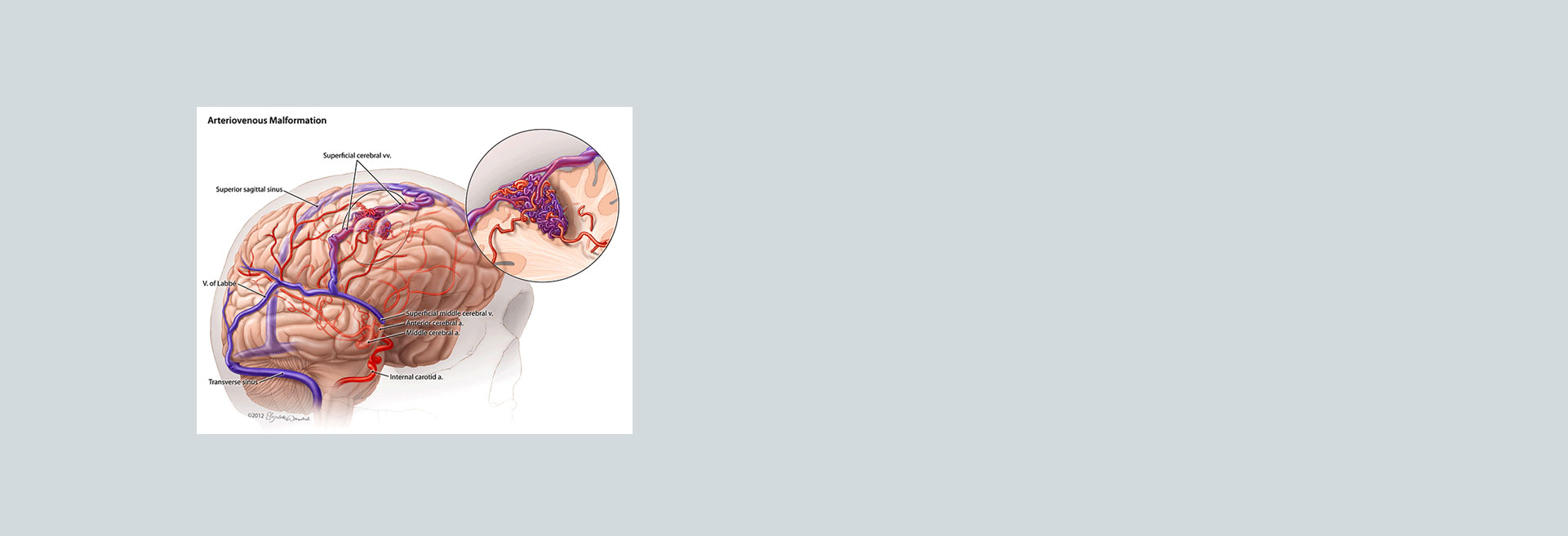WHAT ARE THE SYMPTOMS OF AVM?
The symptoms of an AVM vary, depending on:
- location of the AVM
- size of the AVM
- size of the blood vessels involved in the AVM
You may not have significant symptoms if you have an AVM in the brain. In some cases, brain AVMs cause headaches or seizures. Unfortunately, due to lack of symptoms, this type of AVM often goes undiagnosed or unnoticed until it presents life-threatening symptoms.
Common symptoms of brain AVMs include:
- bleeding in the skull, most commonly a subarachnoid haemorrhage
- seizures
- headaches
- focal neurologic deficits, such as weakness, numbness, or tingling to one part or side of the body
- confusion
If the AVM is elsewhere in the body, the symptoms may be more pronounced.
Common symptoms for AVMs found in the limbs and spinal cord include:
- muscle weakness
- inability to move a limb
- lack of coordination
Common symptoms for AVMs found in the organs, chest, or abdomen include:
- abdominal pain
- back pain
- chest pain
- irregular sounds in the affected blood vessels
Some symptoms in children under age 2 include:
- congestive heart failure, where the heart is unable to pump out the blood that enters it
- seizures
- hydrocephalus, an increase in fluid in the brain that causes swelling
WHERE TO START IF YOU ARE WORRIED ABOUT YOUR HEALTH OR ARE EXPERIENCING ANY OF THE SYMPTOMS PREVIOUSLY STATED
Firstly please contact your GP.
To diagnose an AVM, your doctor will review your symptoms and perform a physical examination.
He or she may listen for a sound called bruit. Bruit is a whooshing sound caused by very rapid blood flow through the arteries and veins of an AVM. It sounds like water rushing through a narrow pipe. Bruit may interfere with hearing or sleep or cause emotional distress.
Tests commonly used to help diagnose AVM include:
- Cerebral angiography. Also called arteriography, this test uses a special dye called a contrast agent injected into an artery. The dye highlights the structure of blood vessels to better show them on X-rays.
- Computerized tomography (CT). CT scans use X-rays to create images of the head, brain or spinal cord and can help show bleeding.
- Magnetic resonance imaging (MRI). An MRI uses powerful magnets and radio waves to show detailed images of the tissues. An MRI can pick up on small changes in these tissues.
- Magnetic resonance angiography (MRA). An MRA captures the pattern and the speed and distance of blood flow through the vascular abnormalities.
- Transcranial Doppler ultrasound. This type of ultrasound uses high-frequency sound waves to create an image of the blood flow to help diagnose large and medium AVMs, as well as bleeding.
- Extra cranial AVMs. AVMs that can be viewed outside the body can be thoroughly examined by your Doctor imaging or biopsy may be taking and more than likely if your seen as at risk you will be referred to an AVM specialist treatment Centre.
WHAT IS AN AVM?
Arteriovenous malformation is an abnormal connection between arteries and veins, bypassing the capillary system. This vascular anomaly is widely known because of its occurrence in the central nervous system (usually cerebral AVM), but can appear in any location.
Although many AVMs are asymptomatic, they can cause intense pain or bleeding or lead to other serious medical problems.
AVMs are usually congenital and belong to the RASopathies.
The genetic transmission patterns of AVMs are incomplete, but there are known genetic mutations (for instance in the epithelial line, tumour suppressor PTEN gene) which can lead to an increased occurrence throughout the body.





Follow us on
This message is only visible to admins:
Problem displaying Facebook posts. Backup cache in use.
Type: OAuthException
Click here to Troubleshoot.
The Butterfly AVM Charity
9 months ago
youtu.be/FhNbTesxEJo ... See MoreSee Less
Share on FacebookShare on TwitterShare on Linked InShare by Email
Comment on Facebook
The Butterfly AVM Charity
9 months ago
✨🦋 We’re happy to announce that tickets for The Butterfly AVM Charity Ball on the 11th November, 2023 are now ON SALE!!! 🦋✨
Doors open: 5:30pm
Dinner served: 6:30pm
What to expect:
- drinks reception 🍸
- three course meal 🥘
- silent auction 🙇🏽♀️
- raffle 🎁
- music 🎤
- dancing & entertainment 🕺🏽
Tickets: £70
Address: The Meridian Grand, Advent Way, London, N18 3AF
We can’t wait to see you there!
🎟️⏳ TICKETS: uk.givergy.com/ButterflyAVMCharityBall/?controller=tickets ... See MoreSee Less
Share on FacebookShare on TwitterShare on Linked InShare by Email
Comment on Facebook
By chance does anyone needs ticket? I ended up with extra than I needed,you know system online messed up, if you need them kindly like my comment and send me a direct message thanks, please I'd hate for them to go to waste.
The Butterfly AVM Charity
9 months ago
A quick message from our very own Nikki Lilly 💜
Tickets to The Butterfly AVM Charity Ball 2023 are out NOW and can be purchased via the link below! 🦋
uk.givergy.com/ButterflyAVMCharityBall/?controller=home ... See MoreSee Less
Share on FacebookShare on TwitterShare on Linked InShare by Email
Comment on Facebook
Loving the hair !!
The Butterfly AVM Charity
9 months ago
✨🦋 We’re happy to announce that tickets for The Butterfly AVM Charity Ball on the 11th November, 2023 are now ON SALE!!! 🦋✨
Doors open: 5:30pm
Dinner served: 6:30pm
What to expect:
⁃ drinks reception 🍸
⁃ three course meal 🥘
⁃ silent auction 🙇🏽♀️
⁃ raffle 🎁
⁃ music 🎤
⁃ dancing & entertainment 🕺🏽
Tickets: £70
Address: The Meridian Grand, Advent Way, London, N18 3AF
We can’t wait to see you there!
You can find the link to buy tickets below and in the event bio 🎟️⏳
uk.givergy.com/ButterflyAVMCharityBall/?controller=home ... See MoreSee Less
This content isn't available right now
When this happens, it's usually because the owner only shared it with a small group of people, changed who can see it or it's been deleted.Share on FacebookShare on TwitterShare on Linked InShare by Email
Comment on Facebook
Just got my tickets for our first ever one! Looking forward to it!
The Butterfly AVM Charity
10 months ago
✨ 🦋 The Butterfly AVM Charity Ball will be back bigger and better than ever on Saturday 11th November 2023! ✨🦋 Tickets on Sale Friday 7th July! Set a Reminder!
✨ 5.30pm - 2.00am, Dinner - 6.30pm ✨
✨ £70.00 ✨
✨ The Meridian Grand, Advent Way, London, N18 3AF ✨
🦋 Cocktail reception | Three course meal | Silent auction | Raffle | Music | Dancing | Entertainment 🦋 ... See MoreSee Less
Share on FacebookShare on TwitterShare on Linked InShare by Email
Comment on Facebook
Looking forward to it!
Stefan Galo
Follow us on
Privacy Overview